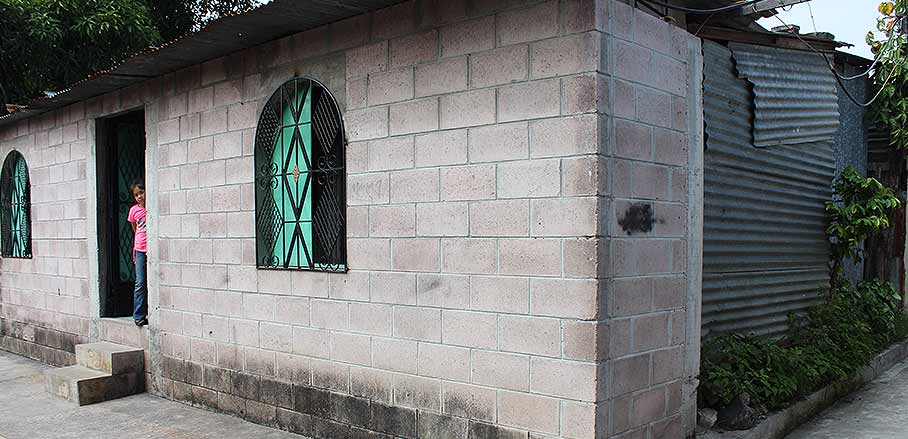From a shack to a house with water and electricity
by KfW Development Bank
In a four-part series, URBANET takes a closer look at specific projects that contribute to making cities more liveable. In this first part, the focus lies on San Salvador, El Salvador’s capital city, where the houses of thousands of families who live in slums are being reconstructed. Since they have gained access to regular water and electricity supply, the living conditions have improved significantly.
Lidia Vasquez, a seamstress, lives in the “24 de Julio” district on the outskirts of San Salvador together with her granddaughter, Miriam. Initially, her home was just a makeshift tin shack – a proverbial roof over her head. But now, it has been transformed into a proper little house. While the walls are still made of corrugated metal sheet to some extent, her home now has a water and electricity connection, an entrance with a landing and concrete paths. Like thousands of other families, Lidia Vasquez is benefiting from a programme that KfW has been using to support slum rehabilitation in the metropolitan area of San Salvador, the capital of El Salvador, on behalf of the Federal Ministry for Economic Cooperation and Development (BMZ).
Lidia Vasquez came to the city in the throes of the civil war that shook the country for many years. She settled down somewhere on the outskirts of the city. At that time, multitudes of migrants from all over the country descended on San Salvador just like her. A shack settlement with very few water points and unpaved paths soon sprung up in the city. In most cases, people would illegally tap electricity from the lines. The paths between the shacks would turn into slippery slopes when it rained. And San Salvador is certainly no stranger to rain – and torrential rain in particular.
Every home is now equipped with toilet facilities instead of latrines
The programme that KfW has been implementing together with the non-governmental organisation FUNDASAL – Fundación Salvadoreña de Desarrollo y Vivienda Mínima – since 1986 and has been promoting to the tune of around EUR 53 million in total has turned Lidia Vasquez’s life around. First of all, a regulated water supply and waste water disposal system was added, followed by electricity connections. These aspects in themselves improved the quality of life a great deal. Next, paths were paved, steps were built and, last but not least, even a community centre was constructed. “It simply doesn’t compare to how things were when we arrived here,” she explains. Nowadays, for instance, each and every home is equipped with toilet facilities instead of latrines.
Just like Lidia Vasquez, more than 90,000 people have now benefited from the measures implemented in and around San Salvador. In a good 40 districts of the city – all of them particularly poor – the living conditions have improved substantially thanks to the programme promoted by KfW. New social facilities – such as community centres, sports fields and play areas – or green and open spaces have been developed too. The residents were all involved in the rehabilitation process. They worked together and helped to make their barrio a more beautiful and comfortable place to live. Violence, which was otherwise fairly commonplace, has been contained as a result, too.
Regulated ownership structures
Lastly, the programme also includes a plan to grant the mostly illegal residents legal rights of residence and ownership. This very complex process has now been completed for almost 90% of families in the areas where the project is being implemented, and plans for the remaining families are in the pipeline. Lidia Vasquez is delighted with her beautiful new surroundings and about the fact that the district’s residents actually clean their houses and pavements – adding, “well, most of them do, anyway”. She herself would like to continue rehabilitating her home – fit a new roof and, maybe one day, replace the corrugated metal sheet walls with stone ones – as soon as she has a deed of ownership. “I no longer want to move away from here,” she smiles, adding, “it’s such a beautiful place now and we must maintain everything that’s been achieved through everyone’s efforts.”
- Mozambique: Rehabilitation of the Chiveve River is improving the quality of life of Beira’s residents - 9. December 2016
- From a shack to a house with water and electricity - 6. December 2016
